January 2008 LIP of the Month
The Chipman Dyke Swarm, Saskatchewan, Canada: Component of the 1.9 Ga Snowbird Large Igneous Province in the western Canadian Shield
Michael L. Williams1, and Rebecca M. Flowers2
- Department of Geosciences, University of Massachusetts, Amherst, MA 01003
- Department of Geological Sciences, University of Colorado, Boulder, CO 80309
Collaborators: Kevin Mahan2, Christopher Kopf3, Julie Baldwin4, Samuel Bowring5
- University of Pittsburgh Johnstown, Johnstown, PA 15904
- Department of Geosciences, University of Montana, Missoula, MT 59812-1296
- Dept. of Earth, Atmospheric and Planetary Sciences, Massachusetts Institute of Technology, Cambridge, Massachusetts 02139
Michael L. Williams [mlw@geo.umass.edu]
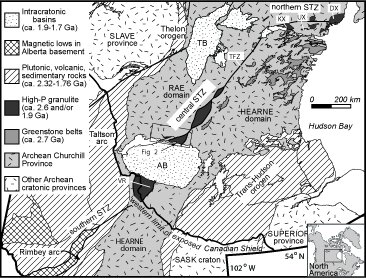
Figure 1: Geological map of the western Canadian shield showing major tectonic features and the trace of the Snowbird tectonic zone. AB Athabasca basin, DX Daly Bay Complex, KX Kramanituar Complex, STZ Snowbird tectonic zone, TB Thelon Basin, TFZ Tulemalu Fault Zone, UX Uvauk Complex, VR Virgin River shear zone. The rectangle shows the East Lake Athabasca region enlarged in Fig. 2. Modified from Flowers et al. (2006).
Introduction
The Snowbird tectonic zone is the geophysically-located boundary between the Rae and Hearne domains that constitute the Western Churchill Province (Goodacre et al. 1987; Hoffman, 1988). It can broadly be divided into three segments: northeastern, central, and southwestern (Fig. 1). Significant volumes of ca. 1.9 Ga mafic magmatism occur in all three segments (see below), and in fact, 1.9 Ga magmatism may be the single common characteristic that links all segments of the Snowbird tectonic zone. Research at the University of Massachusetts and Massachusetts Institute or Technology (MIT) has primarily been focused on the central segment where 1.9 Ga mafic magmatism primarily consists of the extensive and spectacular Chipman Dyke Swarm. The following observations, data, and interpretations come mainly from the Chipman swarm in the East Lake Athabasca area. Possible correlations, north and south, are summarized below, and suggest that this 1.9 Ga large igneous province may extend more than 2800 km along strike.
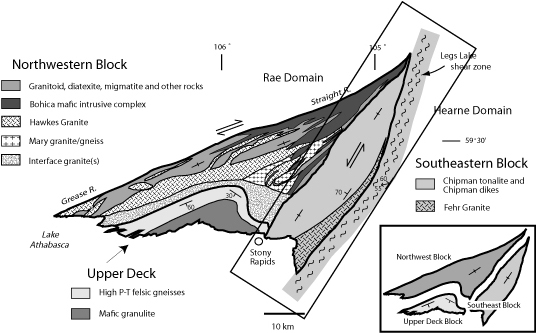
Figure 2: Generalized geologic map of the East Athabasca mylonite triangle (EAmt) or Tantato domain of Gilboy (1980) and inset map showing the location of the three main structural/tectonic blocks (modified from Williams et al., 1995).
Regional Geological Setting
A variety of names have been used to describe a granulite terrane that occurs north and east of Lake Athabasca, Saskatchewan , Canada (Fig. 2). The region was originally named the Tantato domain by Gilboy (1980). It was renamed the East Athabasca mylonite triangle by Hanmer and co-workers (Hanmer 1994; Hanmer et al., 1994, 1995a) based on its northeast tapering geometry and the abundance of mylonitic rocks. The “triangle” forms one major component of the Striding-Athabasca mylonite zone (Hanmer et al., 1995b), essentially the central segment of the Snowbird tectonic zone, a zone of anastamosing granulite facies mylonites stretching from Lake Athabasca to Snowbird Lake in the northwest Territories. Recently, workers have used the terms East Lake Athabasca granulite terrane or more simply, Athabasca granulite terrane, recognizing that the “mylonite triangle” or Tantato domain is only part of a much larger granulite terrane, covering 20,000 km2 or more. The granulite terrane has been interpreted to be a relatively coherent (and minimally reequilibrated) sample of the 1.9 Ga deep crust (Williams and Hanmer, 2006).
The East Athabasca mylonite triangle (Tantato Domain) has been divided into three structural blocks , each with distinct lithologies, structural character, and geologic history (Fig. 2). The northwestern block is dominated by ~2.62-2.60 Ga plutonic rocks, the most extensive of which is the Mary granite (granodiorite) (Hanmer et al., 1994; Hanmer, 1997a; Williams et al., 2000). The Mary granite magma is interpreted to have crystallized as opx-bearing plutons in the lower crust and then to have cooled into the “high pressure” or garnet-granulite stability field. The southern block, called the “upper deck”, has a northeast- to east-striking foliation and south-dipping mylonitic foliation. It contains evidence for a phase very-high-pressure metamorphism (1.5 GPa or more) and contains one or more belts of spectacularly exposed eclogite near the northern boundary with the other structural blocks.
The southeastern block of the East Athabasca mylonite triangle, also called the Chipman domain, is dominated by the Mesoarchean Chipman tonalite, intruded on its eastern flank by the ca.2.6 Ga Fehr granite (Hanmer, et al., 1994; Hanmer, 1997a; Williams and Davis, unpublished data) (Fig. 3). The tonalite is divided into structurally and metamorphically defined units that range from hornblende tonalite with a coarse igneous texture and weak deformational fabric, to intensely deformed garnet- and pyroxene bearing 'straight gneiss' and ribbon mylonite (Hanmer, 1997a).
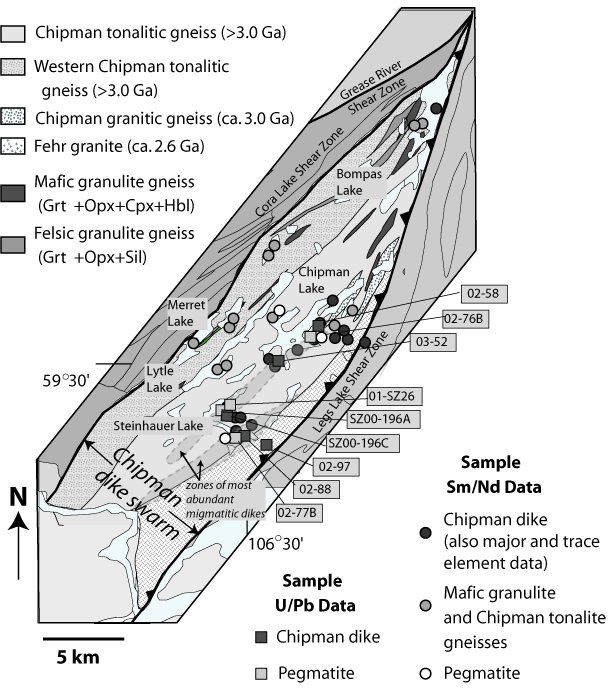
Figure 3: Geological map of the Chipman domain with sample locations. Modified from Flowers et al. (2006).
The Chipman tonalite is intruded by a swarm of mafic dikes, the Chipman dykes. The main part of the swarm coincides with a positive gravity anomaly, which may indicate the presence of more mafic material at depth (Hanmer et al. 1994). The Chipman mafic dyke swarm, originally termed the Chipman sill swarm by Macdonald (1980), is exposed across the width of the Chipman domain. It is truncated laterally by domain-bounding shear zones, and thus originally had greater lateral extent (Fig. 3). Chipman dykes vary in abundance across the span of the swarm, range in width from less than one to tens of meters, and locally comprise 60-100% of the exposure.
Chipman Dykes –Observations
The Chipman dykes generally strike to the northeast, parallel to the dominant tectonic fabric and parallel to the trend of the Snowbird tectonic zone (Fig. 4a). The dykes were synkinematically emplaced during regional deformation (Williams et al., 1995; Hanmer, 1997a). The oldest dykes define isoclinal folds, refolded folds, and sheath folds and display multiple foliations (including S and C foliations (i.e. Berthe et al., 1979), boudinage, and extreme thickness variation (Fig. 4b). Some dykes can be traced along or across strike into zones of intense shearing, locally to the point of becoming streaks or schlieren in the mylonitic tonalite. Younger dykes have sharp contacts that cleanly cut the older, more deformed dykes and the fabric in the mylonitic host tonalite (Fig. 4c). Many of these younger dykes have randomly oriented wall rock inclusions, joint-controlled irregularities along their contacts, and delicate apophyses projecting into the wall rocks. Primary igneous textures including chilled margins and concentrations of plagioclase phenocrysts in the centers of dykes are also common, especially in the least deformed dykes.
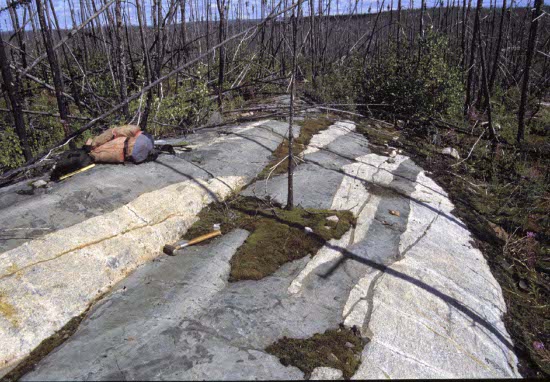
a
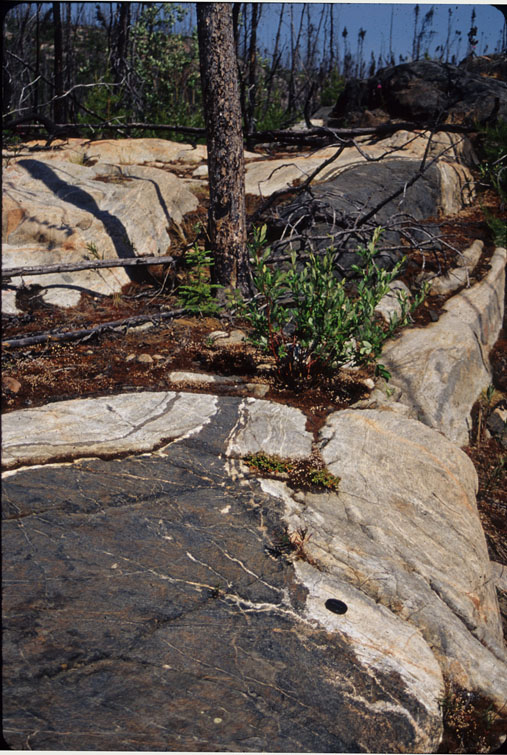
b
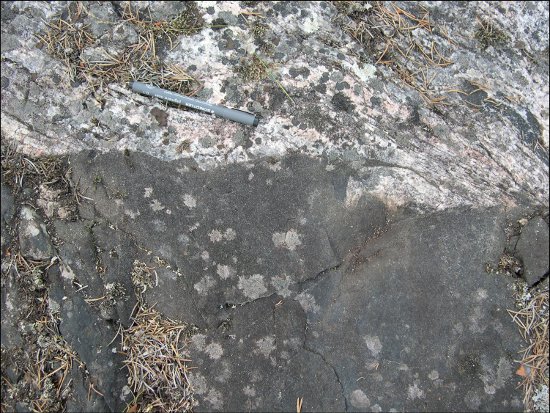
c
Figure 4: Photographs of Chipman dykes. 4a. Field photograph showing relatively narrow Chipman dykes cutting Chipman tonalite. 4b. Boudinage in Chipman dyke. 4c. Chipman dyke margin cross-cutting tonalite fabric and also showing bayonet apophasis.
The Chipman dykes can be divided into two broad textural and mineralogical groups: (1) migmatitic dykes in which garnet crystals are associated with distinctive quartz + plagioclase leucocratic segregations (Figs 5a,b), and (2) nonmigmatitic dykes in which fine-grained garnet and clinopyroxene occur in spherical concentrations with scalloped, cauliflower-shaped boundaries in a medium to course grained, hornblende + plagioclase matrix (Fig 5c). A second, less common, non-migmatitic texture involves extremely large garnet crystals with hornblende-rich rims in a hornblende+plagioclase matrix (Fig. 5d). No consistent age relationships have been observed among these textural varieties, and in some cases, a single dyke hosts two or more of the reaction textures.
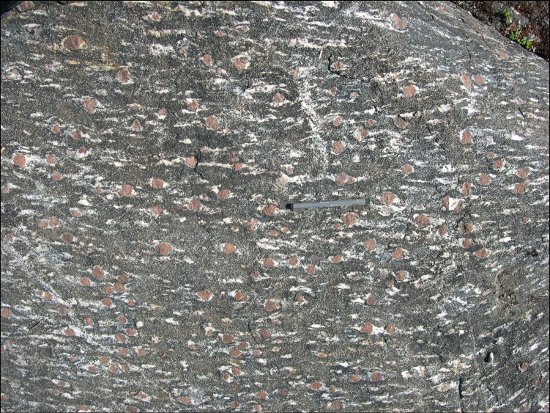
a
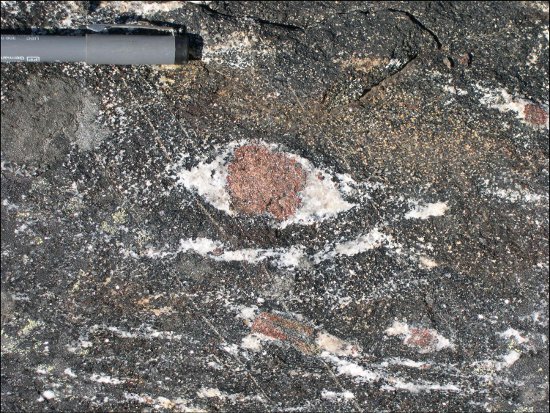
b
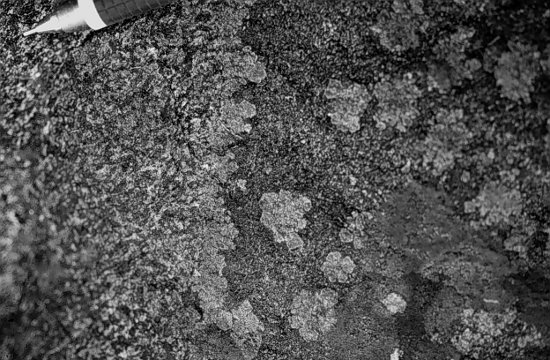
c
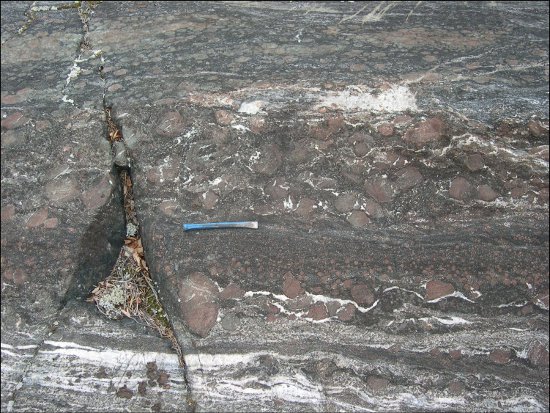
d
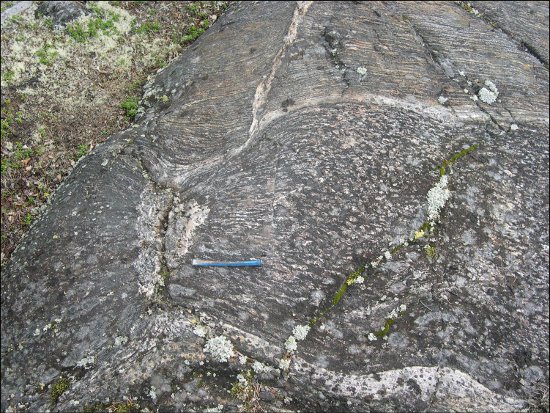
e
Figure 5: Photographs showing petrologic varieties of Chipman dykes. 5a. Migmatitic dyke with garnet and tonalite leucosome tails. 5b. Close-up of garnet with leucosome tail. 5c. “Cauliflower dyke showing Cpx-Grt reaction products in Hb-Pl dyke matrix. 5d. Large Grt with Hb-rich rims. 5e. Boudinage in migmatitic dyke with tonalite leucosome in boudin neck.
The migmatitic dykes are particularly interesting with respect to petrologic and structural processes in the deep crust. In dykes with relatively small garnet porphyroblasts (<2 cm), virtually all leucosomes occur adjacent to garnet, with volumes proportional to the size of the garnet crystals. Dykes with relatively large garnet-leucosome clusters also contain pods, veins, or gashes filled with leucosome material (Williams et al., 1995), interpreted to have coalesced from a number of garnet crystals (Fig. 5e). Most of the tonalite leucosomes are aligned with the dominant foliation, but some display classic C/S fabric elements, or asymmetric tails in pressure shadows on garnet.
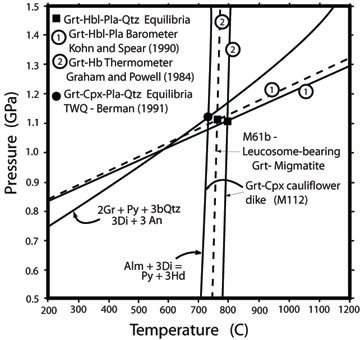
Figure 6: Thermobarometry of selected Chipman dykes. All estimates are based on garnet-hornblende-plagioclase equilibria; equilibrium curves are plotted for only sample M61. Filled circles: migmatitic dykes; Filled squares: non-migmatitic, cauliflower-texture dykes; filled triangle: fine-grained undeformed dyke with plagioclase phenocrysts and fine garnet (<1mm). See Williams et al. (1995) for discussion. Modified from Williams et al. (1995).
All of the dykes investigated indicate high pressure granulite facies conditions, with calculated temperatures on the order of 750-850°C and pressures of approximately 1.0 GPa (Fig. 6), regardless of mineral assemblage (Williams et al. 1995; Flowers et al., 2006). Experimental studies of phase relations suggest that at pressures greater than ~ 0.8 GPa, garnet is an important product phase in the vapor-absent melting of amphibolite (Rushmer 1991; Rapp et al. 1991; Beard & Lofgren 1991; Sawyer 1991; Wolf & Wyllie 1993;1994). The migmatitic Chipman dykes may provide an example of a process capable of producing tonalitic magma in the lower crust by partial melting of amphibolite at high pressure (Williams et al., 1995; see also Percival, 1983; Hartel and Pattison, 1996).
Isotope and Whole Rock Geochemistry of the Chipman Dyke Swarm
Sm-Nd isotopic data and whole rock geochemical data for sixteen Chipman mafic dyke samples impose constraints on their source region(s) (Flowers et al., 2006) (Fig. 7). Chipman mafic dyke eNd values at 1.9 Ga range from –9.1 to +2.2 (Fig. 8). Dykes with higher (> 50.9 %) SiO2 content display an inverse correlation between eNd and SiO2, suggesting that crustal assimilation may have influenced dyke compositions. For example, contamination of the Chipman dykes by a component such as the host Archean Chipman tonalitic gneisses, characterized by evolved Nd isotopic signatures (present-day eNd values from –45.7 to –35.0), can explain the Chipman dyke Nd and geochemical pattern.
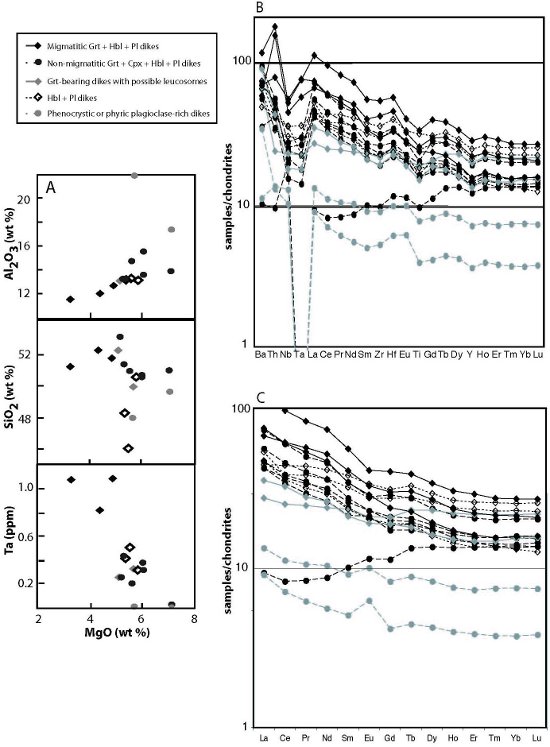
Figure 7: Major and trace element compositions of Chipman mafic dykes. a Plots of l2O3 (weight %), SiO2 (weight %), and Ta (ppm) versus MgO (weight %). b Spider diagram for Chipman mafic dyke samples. c REE diagram for Chipman mafic dyke samples. Chrondrite values for both spider and REE diagrams from Sun and McDonough (1989). Modified from Flowers et al. (2006).
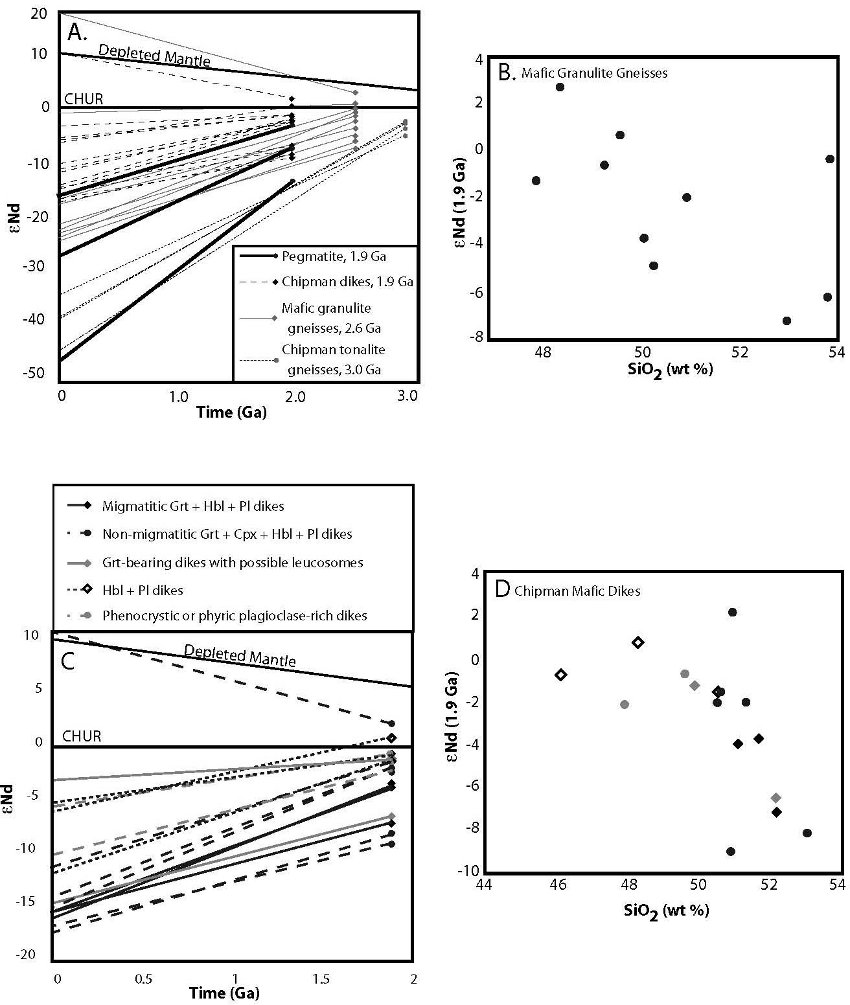
Figure 8: Nd isotope evolution diagram for Chipman mafic dykes corrected to 1.9 Ga, for pegmatite dykes corrected to 1.9 Ga, for mafic granulite gneisses corrected to 2.6 Ga, and for Chipman tonalitic gneisses corrected to 3.0 Ga. b Plot of eNd at 2.6 Ga versus SiO2 for mafic granulite gneisses. c Nd isotope evolution diagram for Chipman mafic dyke samples corrected to 1.9 Ga. d Plot of eNd at 1.9 Ga versus SiO2 for Chipman mafic dykes. The inverse correlation between eNd and SiO2 for dykes with higher (>50.9%)
SiO2 content suggests the influence of crustal assimilation on this subset of dykes. From Flowers et al. (2006).
The Chipman mafic dyke geochemistry is characterized by HFSE depletions and LILE enrichments. Such a pattern is characteristic of arc magmas, and could reflect 1) derivation from enriched lithospheric mantle previously affected by subduction-related processes as has been interpreted elsewhere in the western Churchill Province, or 2) derivation from depleted lithospheric mantle or asthenosphere and assimilation of subduction related felsic intrusives. The Nd isotopic data has bearing on this issue. Exclusion of dykes with higher SiO2 content that may have been influenced by crustal contamination yields a more restricted range of 1.9 Ga eNd values from –2.1 to 2.2. A contribution from a minor enriched lithospheric mantle component as inferred for other Proterozoic intrusives in the Western Churchill Province, such as the Christopher Island Formation (Cousens et al., 2001), cannot be excluded. However, the more restricted Chipman dyke values do not overlap those reported for the Christopher Island Formation. Thus, the Chipman mafic dyke geochemical and isotopic signatures appear most consistent with derivation from a predominantly depleted lithospheric or asthenospheric mantle source with assimilation of older subduction-related intrusives during emplacement (Flowers et al., 2006).
Geochronology of the Chipman Dyke Swarm
High-precision U-Pb ID-TIMS geochronology for migmatitic Chipman dykes tightly constrains the timing of anatexis during high-P granulite facies metamorphism in the Chipman domain (Flowers et al., 2006). Because field relationships are most simply explained by synmetamorphic and syntectonic emplacement of the dykes, we consider the timing of dyke anatexis to also represent the timing of dyke emplacement. Although non-migmatitic dykes were also processed for accessory minerals, no zircon grains were recovered, suggesting that zircon grew during dyke anatexis rather than igneous crystallization.
Four migmatitic dykes collected across the corridor of dyke anatexis yielded indistinguishable weighted mean 207Pb/206Pb dates from 1896.7 ± 0.8 Ma to 1895.5 ± 0.5 Ma (Fig. 9). These data suggest that the duration of dyke migmatization at exposed crustal levels was ≤ 2.5 m.y., established by the errors on the range of sample zircon dates. It is not certain whether the onset of high-grade conditions in the Chipman domain coincided with dyke emplacement, or commenced at an earlier time. However, the data collectively indicate that 1896 Ma represents the timing of dyke intrusion, high-P (ca 1.0-1.2 GPa) metamorphism, and migmatization (>750 °C, 1.0-1.2 GPa).
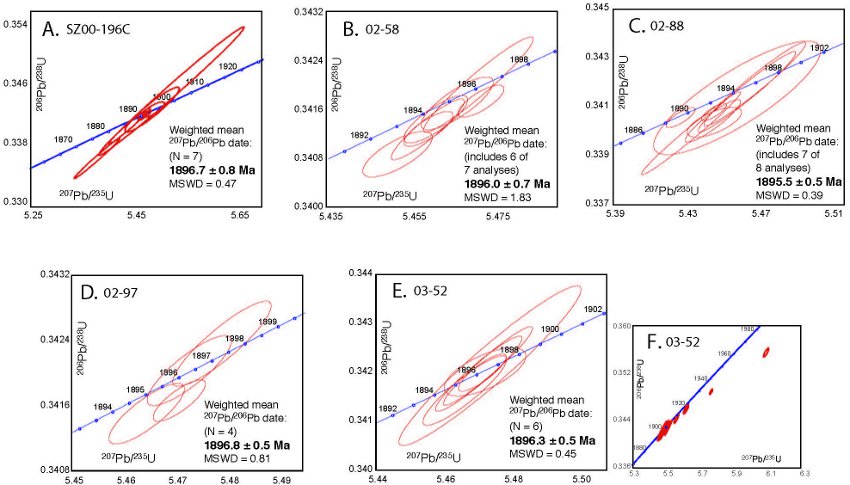
Figure 9: Concordia diagrams for migmatitic dykes. See text for discussion. From Flowers et al. (2006).
Regional Correlations
The intrusion and metamorphism of the 1896 Ma Chipman mafic dykes are part of significant Proterozoic mafic magmatism along the central Snowbird tectonic zone. The Virgin River dykes are along-strike upper amphibolite facies mafic dykes exposed 400 km southwest of the Chipman dykes, are truncated on their eastern side by the Virgin River shear zone, and have previously been correlated with the Chipman dykes and Legs Lake Shear Zone (Fig. 1) (Card, 2002; Mahan et al., 2003). To the northeast in the Selwyn lozenge, 1.1 GPa, 800 C granulite facies mafic dykes intrude rocks similar to the Chipman tonalite and are also truncated by a thrust sense shear zone considered the continuation of the LLSZ on their eastern side (Mahan and Williams, 2005). The NE striking Kazan dykes 400 km northeast of the East Athabasca region have yielded bulk K–Ar dates of ca. 1.9 Ga, contain remnant garnet and clinopyroxene, and intrude a ~25 km wide zone along the Tulemalu fault zone (Fahrig et al., 1984) that has been correlated with the Virgin River and Legs Lake-Black Lake shear zones (Tella and Eade, 1986). A strong genetic link among these exposures is provided by the similar relationships, kinematics, location and apparent timing of mafic dykes and shear zone for 800 km along strike (Flowers et al., 2006). This correlation establishes the Chipman dykes as a substantial mafic dyke swarm of regional significance.
Emplacement of the Chipman mafic dyke swarm was approximately coincident with major mafic magmatism along the northern Snowbird tectonic zone, 600–800 km northeast of the East Lake Athabasca region. This magmatism includes the massive ca. 1.9 Ga Kramanituar, Uvauk, and Daly Bay mafic granulite complexes (Gordon, 1988; Mills et al., 2000; Sanborn-Barrie et al., 2001; Hanmer and Williams, 2001). In addition, to the south the subsurface extension of the Snowbird tectonic zone was interpreted to record the opening and closure of a marginal Proterozoic ocean basin (Ross et al. 1995, 2000) (Fig. 1). Ocean basin development is tectonically compatible with synchronous along-strike mafic magmatism. Together, these data indicate widespread 1.9 Ga mafic magmatism for >1,200 km of the Snowbird tectonic zone, and potential links to the south that would extend the correlation along the entire 2,800 km length of the geophysical lineament (Flowers et al., 2006).
Speculations
Evidence for a prolonged period of lithospheric stability in the East Lake Athabasca region prior to the 1.9 Ga Chipman mafic magmatism suggests that the Proterozoic event was severe enough to disrupt a stable Archean craton. We suggest the magmatism was driven by a continental-scale 1.9 Ga episode of asthenospheric upwelling that drove significant mass and thermal input to the crust (Fig. 10). The ca. 1.9 Ga activity along the Snowbird tectonic zone is spatially and temporally bounded by the 1.91-2.02 Ga Taltson-Thelon orogen to the northwest and the 1.81-1.91 Ga Trans-Hudson orogen to the southeast. These two inward-dipping collision zones would have dramatically impacted the intervening Churchill Province lithosphere during the assembly of Laurentia. The opening of an ocean basin along the southern Snowbird tectonic zone (Ross et al. 2000) may have been followed by northward propagation of an incipient continental rift along the central Snowbird tectonic zone. Models to accommodate initial basin formation include 1) extension induced by a central zone of asthenospheric upwelling and lithospheric thinning as a convective response to the trench suction force exerted by lateral downgoing slab(s) (e.g. Bott, 1982), and 2) hinterland transtension due to a strike-slip dominated regime initially driven by Slave collision as has been postulated for opening of a Proterozoic marginal basin along the southern Snowbird tectonic zone (Ross et al., 1995, 2000). If the Snowbird tectonic zone presented an ancestral NE-striking corridor of lithospheric weakness, this may have further enhanced and guided Proterozoic rift propagation, as proposed for other continental rifts (e.g. Courtillot, 1982). Ongoing study is being carried out to establish the significance and nature of Archean northeast-striking structures, and will clarify how they may have controlled subsequent tectonism. Accretionary activity to the east associated with Trans-Hudson orogenesis may have driven a subsequent transition to hinterland contraction, contributing to basin closure along the southern Snowbird tectonic zone, terminating dyke emplacement and incipient rifting along the central segment, and ending mafic complex development in the northern segment.
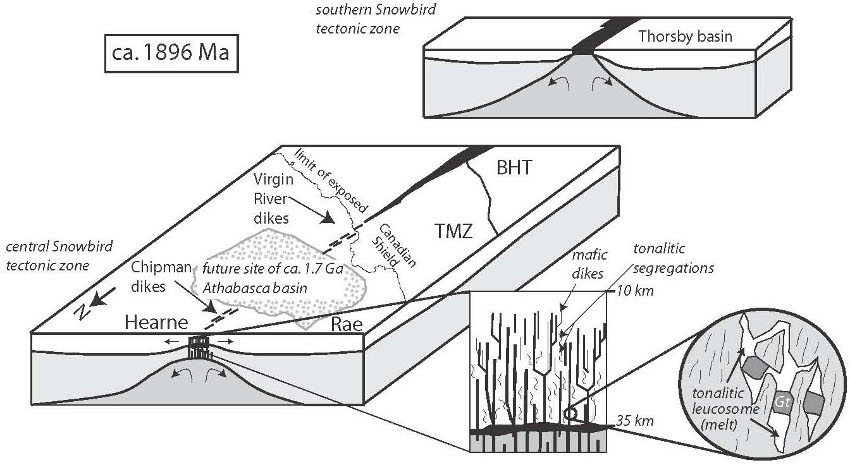
Figure 10: Block diagram depicting the tectonic environment envisioned to the south. Development of a Proterozoic marginal basin, the Thorsby basin, along the southern Snowbird tectonic zone (Ross et al., 2000), may have been followed by northward propagation of an incipient rift marked by intrusion of the Virgin River and Chipman mafic dykes. The traces of the dyke swarms are shown at the surface in order to illustrate the distribution of the mafic magmatism, but in reality the dykes probably did not reach the surface. Insets show the emplacement of the Chipman mafic dykes in the deep crust and the generation of tonalitic melts through amphibolite anatexis. BHT Buffalo Head Terrane, TMZ Taltson Magmatic Zone. From Flowers et al. (2006).
The scenario described above provides a means to coherently link observations in the southern, central and northern segments of the Snowbird tectonic zone. The mafic magmatism along this lineament may have been key in imparting the distinctive gravity and magnetic anomalies that define this fundamental geophysical feature. This mafic magmatism is a fundamental component of the ca. 1.9 Ga event in the western Canadian shield, that must be incorporated into any model that attempts to explain the history of this region.
Acknowledgements
Fieldwork in the Chipman block was carried out by: Julie Baldwin, Mark Darrach, Rebecca Flowers, Simon Hanmer, Christopher Kopf, Kevin Mahan, and Michael Williams with assistance by Alexis Ault, David Hoffman-Setka, Dan Mackie, Erwin Melis, and David Snoyenbos. Funding was provided by National Science Foundation grant EAR-0310215 to S.A. Bowring and M.L. Williams, and a NSF Graduate Fellowship and a GSA student research grant to R.M. Flowers.
Summary References
Flowers, R. M., Bowring, S. A., and Williams, M. L., 2006, Timescales and significance of high-pressure, high-temperature metamorphism and mafic dike anatexis, Snowbird tectonic zone, Canada: Contributions to Mineralogy and Petrology, v. 151, no. 5, p. 558-581.
Williams, M. L., Hanmer, S., Kopf, C., and Darrach, M., 1995, Syntectonic generation and segregation of tonalitic melts from amphibolite dikes in the lower crust, Striding-Athabasca mylonite zone, northern Saskatchewan: Journal of Geophysical Research, v. 100, no. B8, p. 15717-15734.
References Cited
Beard, J. S., and Lofgren, G. E., 1991, Dehydration melting and water-saturated melting of basaltic and andesitic greenstones and amphibolites at 1, 3, and 6.9kb: Journal of Petrology, v. 32, p. 365-401.
Berthe, D., Choukroune, P., and Jegouzo, P., 1979, Orthogneiss, mylonite and noncoaxial deformation of granites:the example of the South Armorican Shear Zone: Journal of Structural Geology, v. Vol. 1, p. 31-42.
Bott, M. H. P., 1982, The mechanism of continental splitting: Tectonophysics, v. 81, p. 301-309.
Card, C. A., 2002, New investigations of basement to the western Athabasca Basin: Summary of Investigations v2, Saskatchewan Geological Survey, Sask Industry Resources, Miscellaneous Report, v. 2002-4.2 CD-ROM, Paper D-12, p. 17.
Courtillot, V., 1982, Propagating rifts and continental breakup: Tectonics, v. 1, p. 239-250.
Cousens, B. L., Aspler, L. B., Chiarenzelli, J. R., Donaldson, J. A., Sandeman, H., Peterson, T. D., and LeCheminant, A. N., 2001, Enriched Archean lithospheric mantle beneath western Churchill Province tapped during Paleoproterozoic orogenesis: Geology, v. 29, p. 827-830.
Fahrig, W. F., Christie, K. W., Eade, K. E., and Tella , S., 1984, Paleomagnetism of the Tulemalu dykes, Northwest Territories, Canada: Canadian Journal of Earth Sciences, v. 21, p. 544–553.
Flowers, R. M., Bowring, S. A., and Williams, M. L., 2006, Timescales and significance of high-pressure, high-temperature metamorphism and mafic dike anatexis, Snowbird tectonic zone, Canada: Contributions to Mineralogy and Petrology, v. 151, no. 5, p. 558-581.
Gilboy, C. F., 1980, Bedrock Compilation Geology: Stony Rapids Area (NTS 74-); Preliminary Geologic Map, scale 1:250,000: Saskatchewan Geological Survey, Saskatchewan Energy and Mines.
Goodacre, A. K., Grieve, R. A. F., Halpenny, J. F., and Sharpton, V. L., 1987, Horizontal gradient of the Bouguer gravity anomaly map of Canada: Geological Survey of Canada, Canadian Geophysical Atlas, Map 5, scale 1:10 000 000.
Gordon, T. M., 1988, Precambrian geology of the Daly Bay area, District of Keewatin: Geological Survey of Canada Memoir, v. 422, p. 21.
Hanmer, S., 1994, Geology, East Athabasca mylonite triangle, Stony Rapids area, northern Saskatchewan, parts of NTS 740-O and 74-P: Geological Survey of Canada Map 1859A, Geological Survey of Canada, scale 1-100,000.
Hanmer, S., 1997, Geology of the Striding-Athabasca mylonite zone, northern Saskatchewan and southeastern District of Mackenzie, Northwest Territories: Geological Survey of Canada Bulletin, v. 501, p. 1-92.
Hanmer, S., Kopf, C., and Williams, M., 1995, Modest movements, spectacular fabrics in a intracontinental deep-crustal strike-slip fault: Striding-Athabasca mylonite zone, NW Canadian Shield: Journal of Structural Geology, v. 17, no. 4, p. 493-507.
Hanmer, S., Parrish, R., Williams, M., and Kopf, C., 1994, Striding-Athabasca mylonite zone: Complex Archean deep crustal deformation in the East Athabasca Mylonite Triangle, N. Saskatchewan: Canadian Journal of Earth Sciences, v. 31, p. 1287-1300.
Hanmer, S., Williams, M., and Kopf, C., 1995, Striding-Athabasca mylonite zone: implications for the Archean and Early Proterozoic tectonics of the western Canadian Shield: Canadian Journal of Earth Sciences, v. 32, p. 178-196.
Hanmer, S., and Williams, M. L., 2001, Targeted fieldwork in the Daly Bay Complex, Hudson Bay, Nunavut: Geological Survey of Canada Current Research, v. 2001, p. C15.
Hartel, T. H. D., and Pattison, D. R. M., 1996, Genesis of the Kapuskasing (Ontario) migmatitic mafic granulites by dehydration melting of amphibolite: the importance of quartz to reaction progress: Journal of Metamorphic Geology, v. 14, p. 591-611.
Hoffman, P. F., 1988, United Plates of America, the birth of a craton: Early Proterozoic assembly and growth of Laurentia: Annual Review of Earth and Planetary Sciences, v. 16, p. 543-603.
Macdonald, R., 1980, New edition of the geological map of Saskatchewan, Precambrian Shield area: Summary of Investigations, Saskatchewan Geological Survey, 1980, p. 19-21.
Mahan, K. H., and Williams, M. L., 2005, Reconstruction of a large deep-crustal terrane: Implications for the Snowbird tectonic zone and early growth of Laurentia: Geology, v. 33, p. 385–388.
Mahan, K. H., Williams, M. L., and Baldwin, J. A., 2003, Contractional uplift of deep crustal rocks along the Legs Lake shear zone, western Churchill Province, Canadian Shield: Canadian Journal of Earth Sciences, v. 40, p. 1085-1110.
Mills, A., Berman, R., Hanmer, S., and Davis, B., 2000, New insights into the tectonometamorphic history of the Uvauk complex, Nunavut: Geological Association of Canada Annual Meeting Abstracts, p. 733.
Percival, J. A., 1983, High-grade metamorphism in the Chapleau-Foleyet area, Ontario: American Mineralogist, v. 68, p. 667-686.
Rapp, R. P., Watson, E. B., and Miller, C. F., 1991, Partial melting of amphibolite/eclogite and the origin of Archean trondhjemites and tonalites: Precambrian Research, v. 51, p. 1-25.
Ross, G. M., Eaton, D. W., Boerner, D. E., and Miles, W., 2000, Tectonic entrapment and its role in the evolution of continental lithosphere: An example from the Precambrian of western Canada: Tectonics, v. 19, p. 116-134.
Ross, G. M., Milkereit, B., Eaton, D., White, D., Kanasewich, E. R., and Burianyk, M. J. A., 1995, Paleoproterozoic collisional orogen beneath the western Canada sedimentary basin imaged by Lithoprobe crustal seismic reflection data: Geology, v. 23, p. 195-199.
Rushmer, T., 1991, Partial melting of two amphibolites: contrasting experimental results under fluid-absent conditions: Contributions to Mineralogy and Petrology, v. 107, p. 41-59.
Sanborn-Barrie, M., Carr, S. D., and Theriault, R., 2001, Geochronological constraints on metamorphism, magmatism and exhumation of deep-crustal rocks of the Kramanituar Complex, with implications for the Paleoproterozoic evolution of the Archean western Churchill Province, Canada: Contributions to Mineralogy and Petrology, v. 141, p. 592-612.
Sawyer, E. W., 1991, Disequilibrium melting and the rate of melt-residuum separation during migmatization of mafic rocks from the Grenville Front, Quebec: Journal of Petrology, v. 32, p. 701-738.
Sun, S. S., and McDonough, W. F., 1989, Chemical and isotopic systematics of oceanic basalts: implications for mantle composition and processes. In: Saunders AD, Norry MJ (eds) Magmatism in oceanic basins: Geological Society Special Publication, p. 313-345.
Tella, S., and Eade, K. E., 1986, Occurrence and possible tectonic significance of high-pressure granulite fragments in the Tulemalu fault zone, District of Keewatin, N.W.T.: Canadian Journal of Earth Sciences, v. 23, p. 1950-1962.
Williams, M. L., and Hanmer, S., 2006, Structural and metamorphic processes in the lower crust: evidence from the East Athabasca mylonite triangle, Canada, a deep-crustal isobarically cooled terrane., in Brown, M., and Rushmer, T., eds., Evolution and Differentiation of the Continental Crust, Cambridge University Press, p. 231-267.
Williams, M. L., Hanmer, S., Kopf, C., and Darrach, M., 1995, Syntectonic generation and segregation of tonalitic melts from amphibolite dikes in the lower crust, Striding-Athabasca mylonite zone, northern Saskatchewan: Journal of Geophysical Research, v. 100, no. B8, p. 15717-15734.
Williams, M. L., Melis, E. A., Kopf, C., and Hanmer, S., 2000, Microstructural tectonometamorphic processes and the development of gneissic layering: A mechanism for metamorphic segregation: Journal of Metamorphic Geology, v. 18, p. 41-57.
Wolf, M. B., and Wyllie, P. J., 1993, Garnet growth during amphibolite anatexis: implications of a garnetifeous restite: Journal of Geology, v. 101, p. 357-373.
Wolf, M. B., and Wyllie, P. J, 1994, Dehydration-melting of amphibolite at 10 kbar: the effects of temperature and time: Contributions to Mineralogy and Petrology, v. 115, p. 369-383.
